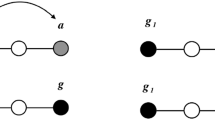Abstract
We consider the “all guards move” model for the eternal dominating set problem. A set of guards form a dominating set on a graph and at the beginning of each round, a vertex not in the dominating set is attacked. To defend against the attack, the guards move (each guard either passes or moves to a neighboring vertex) to form a dominating set that includes the attacked vertex. The minimum number of guards required to defend against any sequence of attacks is the “eternal domination number” of the graph. In 2005, it was conjectured [Goddard et al. (J. Combin. Math. Combin. Comput. 52:169–180, 2005)] there would be no advantage to allow multiple guards to occupy the same vertex during a round. We show this is, in fact, false. We also describe algorithms to determine the eternal domination number for both models for eternal domination and examine the related combinatorial game, which makes use of the reduced canonical form of games.


Similar content being viewed by others
References
Albert MH, Nowakowski RJ, Wolfe D (2007) Lessons in play. A K Peters Ltd, Massachusetts
Arquilla J, Fredricksen H (1995) “Graphing” an optimal grand strategy. Mil Oper Res 1(3):3–17
Beaton I, Finbow S, MacDonald JA (2013) Eternal domination numbers of \(4 \times n\) grid graphs. J Combin Math Combin Comput 85:33–48
Berlekamp ER, Conway JH, Guy RK (2001) Winning ways for your mathematical plays, vol 1, 2nd edn. A K Peters Ltd, Massachusetts
Burger AP, Cockayne EJ, Gründlingh WR, Mynhardt CM, van Vuuren JH, Winterbach W (2004) Infinite order domination in graphs. J Combin Math Combin Comput 50:179–194
Finbow S, Messinger ME, van Bommel M (2015) Eternal domination of \(3 \times n\) grid graphs. Aust J Combin 61(2):156–174
Fomin FV, Kratsch D (2010) Exact exponential algorithms, texts in theoretical computer science. Springer, Berlin
Fricke GH, Hedetniemi SM, Hedetniemi ST (2011) \(\gamma \)-graphs of graphs. Disc Math Graph Theory 31:517–531
Goddard W, Hedetniemi SM, Hedetniemi ST (2005) Eternal security in graphs. J Combin Math Combin Comput 52:169–180
Grossman JP, Siegel A (2009) Reductions of partizan games. In: Albert MH, Nowakowski RJ (eds) Games of no chance 3. Cambridge University Press, New York, pp 427–445
Klostermeyer WF, MacGillivray G (2009) Eternal dominating sets in graphs. J Combin Math Combin Comput 68:97–111
Klostermeyer WF, Mynhardt CM (2016) Protecting a graph with mobile guards. Appl Anal Disc Math 10:1–29
McCuaig W, Shepherd B (1989) Domination in graphs with minimum degree two. J Gr Theory 13:749–762
ReVelle CS (1997) Can you protect the Roman empire? John Hopkins Mag 50(2):40
ReVelle CS, Rosing KE (2000) Defendens Imperium Romanum: a classical problem in military strategy. Am Math Mon 107(7):585–594
Siegel AN (2013) Combinatorial game theory. American Mathematical Society, Providence
Stewart I (1999) Defend the Roman empire!. Sci Am 281:136–138
Woeginger GJ (2001) Exact algorithms for NP-hard problems: a survey. In: Proc. of the 5th international workshop on combinatorial optimization, Springer LNCS 2570, Berlin, pp 185–208
Acknowledgements
S. Finbow acknowledges research support from the Natural Sciences and Engineering Research Council of Canada (Grant Application 2014-06571). Serge Gaspers is the recipient of an Australian Research Council (ARC) Future Fellowship (Project Number FT140100048) and he also acknowledges support under the ARC’s Discovery Projects Funding Scheme (DP150101134). M.E. Messinger acknowledges research support from the Natural Sciences and Engineering Research Council of Canada (Grant Application 356119-2011). The authors acknowledge support from the Games and Graphs Collaborative Research Group of the Atlantic Association for Research in Mathematical Sciences.
Author information
Authors and Affiliations
Corresponding author
Rights and permissions
About this article
Cite this article
Finbow, S., Gaspers, S., Messinger, ME. et al. A note on the eternal dominating set problem. Int J Game Theory 47, 543–555 (2018). https://doi.org/10.1007/s00182-018-0623-0
Accepted:
Published:
Issue Date:
DOI: https://doi.org/10.1007/s00182-018-0623-0




